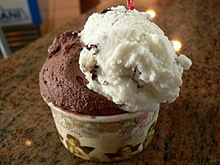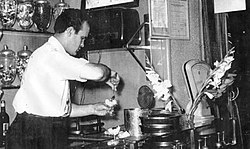 Stracciatella ice cream cone Stracciatella ice cream cone | |
| Type | Ice cream |
|---|---|
| Place of origin | Italy |
| Region or state | Lombardy |
| Created by | Enrico Panattoni |
| Invented | 1961 |
| Main ingredients | Milk, cream, sugar, milk chocolate |
| Ingredients generally used | Dark chocolate |
Stracciatella (Italian: [strattʃaˈtɛlla]) is a variety of gelato, consisting of fine strands of drizzled chocolate stirred through it. It was originally created in Bergamo, northern Italy, at the Ristorante La Marianna in 1961. Stracciatella was inspired by stracciatella soup, made from broth into which beaten egg is drizzled, popular around Rome. It is one of the most renowned Italian gelato flavors.
Description

Makers produce the effect by drizzling melted chocolate into plain milk ice cream towards the end of the churning process; the chocolate solidifies immediately after coming in contact with the cold ice cream, and is then broken up and incorporated into the ice cream with a spatula. This process creates the shreds of chocolate that give stracciatella its name, the word meaning 'little shred' in Italian. While stracciatella ice cream traditionally involves milk ice cream and milk chocolate, modern variations can also be made with vanilla and dark chocolate. Manufactured versions, especially in North America, often use grated or chopped chocolate chips in place of fine drizzled streams.
Origin

Enrico Panattoni, the owner of La Marianna, a gelateria in Bergamo, in northern Italy, invented the dish in 1961. According to Panattoni, the idea came to him after he had grown tired of stirring eggs into broth to satisfy customers of his restaurant who kept asking for stracciatella soup.
He was passionate about cooking and pastry and, after numerous experiments, he produced a white ice cream made of cream peppered with irregular pieces of dark chocolate. During the freezing process, he inserted a dose of melted dark chocolate that was instantly solidified and then shredded by the paddles of the ice-cream machine.
The melted chocolate that solidifies and shatters in the batch freezer is reminiscent of the egg that binds in the boiling broth of the stracciatella alla romana. "Stracciatella alla romana was the most famous consommé and, along with that soup, I was looking for an ice cream that could be loved and appreciated by my customers", said Panattoni.
See also
![]() Media related to Stracciatella (ice cream) at Wikimedia Commons
Media related to Stracciatella (ice cream) at Wikimedia Commons
Notes
- The youngest member of a family of peasant farmers from Altopascio, in Tuscany, Enrico Panattoni (1927–2013) came to Bergamo in 1946 where, after initially managing to set up a bar selling castagnaccio (a simple chestnut-flour cake), he opened La Marianna, which became renowned for its gelato, including stracciatella, as well as its upper-storey Tuscan restaurant, then a novelty in Bergamo. In 1973, Panattoni's son Mirko was kidnapped and later released by an unknown criminal group—the first of a series of children held to ransom in Italy in recent decades.
References
- ^ Ferrari, Luciano (2005). "Straciatella Gelato". Gelato and Gourmet Frozen Desserts - A professional learning guide. Lulu.com. p. 61. ISBN 978-1-4092-8850-3.
- King, Carol (2013). "Top Five Italian Gelato Flavors". Retrieved April 17, 2016.
- n/a, Anders (November 6, 2012). "Quick Stracciatella". Retrieved April 17, 2016.
- Torre, Paul (June 14, 2009). "Stracciatella Gelato". The Italian Chef. Archived from the original on April 20, 2016. Retrieved October 4, 2013.
- "Stracciatella Gelato". recipesfromitaly.com/.
{{cite web}}: CS1 maint: url-status (link) - ^ "Lutto nel mondo della ristorazione – È morto Enrico Panattoni". L'Eco di Bergamo (in Italian). October 4, 2013. Retrieved October 4, 2013.
- "Enrico Panattoni, la sua storia". L'Eco di Bergamo (in Italian). October 4, 2013. Retrieved October 4, 2013.
- "Inventor of 'stracciatella' ice cream dies at 85". Gazzetta del Sud (online). October 4, 2013. Archived from the original on October 19, 2013. Retrieved October 8, 2013.
- "La stracciatella". La Marianna (in Italian). Retrieved December 20, 2020.
- "Storia – La Stracciatella" (in Italian). Retrieved December 20, 2020.